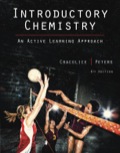
(a)
Interpretation:
The name of HBrO2 is to be stated.
Concept introduction:
Commonly, the particles possessing by chemical compounds are usually represented by chemical formulas. Besides, the chemical formula of a substance is having the
(b)
Interpretation:
The formula of tellurous acid (tellurium, Z = 52) is to be stated.
Concept introduction:
The particles possessing by chemical compounds are usually represented by chemical formulas. Besides, the chemical formula of a substance is having the symbols of element using which the chemical compound is made. Generally, in a chemical formula, the subscript number after a symbol denotes the number of atoms of the element in the formula unit of the substance. If the compound is having only one atom of an element of interest, the subscript is omitted.
Trending nowThis is a popular solution!

Chapter 6 Solutions
EBK INTRODUCTORY CHEMISTRY: AN ACTIVE L
- 18. Give the number of protons and electrons in ( a) a C 60 molecule . ( b) a CN^ - ion . ( c) a CO 2 molecule . ( d ) an N^ 3- ionarrow_forward(a) What is the formula of carbon disulfi de? (b) What is the name of PCl5? (c) Give the name and formula of the compound whose molecules each consist of two N atoms and four O atoms.arrow_forwardWhich acid has an incorrect name? (A) H2SO3 = sulfurous acid (B) HClO3 = chlorous acid (C) H2CO3 = carbonic acid (D) HNO3 = nitric acidarrow_forward
- The number of protons, neutrons, and electrons, respectively, in the ionic species 209 9Bi* :3+ 83 are: (A) 83, 126, 80; (B) 83, 209, 80; (C) 86, 209, 83; (D) 83, 126, 86;arrow_forward2.43 g magnesium was completely burnt in oxygen to give magnesium oxide. 2 Mg(s) + O2(g) → 2 MgO(s) (Relative atomic masses: O = 16.0, Mg = 24.3) (a) Draw the electronic diagrams of O2 and MgO, showing electrons in the outermost shell only. (b) (i) How many mole of magnesium was present? (ii) How many mole of oxygen was required to completely react with the amount of magnesium in (i)? (iii) Hence, calculate the amount of oxygen required to completely react with the magnesium. (c) Similarly, calculate the amount of MgO formed.arrow_forwardEach of the following names is incorrect. Give the correct names. (a) CrCl2, chromium(I) chloride(b) Zn(NO3)2, zinc(II) nitrate(c) CrN, chromium(I) nitridearrow_forward
- Capsaicin, the compound that gives the lhot taste to chili peppers, has the formula C18H27NO3.(a) Calculate its molar mass.(b) If you eat 55 mg of capsaicin, what amount (moles) have you consumed?(c) Calculate the mass percent of each element in the compound.(d) What mass of carbon (in milligrams) is there in 55 mg of capsaicin?arrow_forward(a) What is a hydrocarbon? (b) Butane is the alkane with a chain of four carbon atoms. Write a structural formula for this compound and determine its molecular and empirical formulas.arrow_forwardWhich of these compounds is named correctly? (A) MnO2 = manganese(II) oxide (B) Cu2S = copper(I) sulfide (C) Na3PO4 = trisodium phosphate (D) CaF2 = calcium(II) fluoridearrow_forward
- How many protons, neutrons, and electrons, respectively, are present in the ionic species 19779Au3+? (A) 79, 197, 76; (B) 79, 118, 3; (C) 76, 118, 79; (D) 79, 118, 76;arrow_forwardCorrect the formula to match the name of the followingcompounds: (a) iron(III) oxide, Fe₃O₄; (b) chloric acid, HCl; (c) mercuric oxide, Hg₂O; (d) dichlorine heptaoxide, Cl₂O₆arrow_forward7. Isotopes. (a) Argon has three naturally occurring isotopes, 36Ar, 38Ar, and 40Ar. What is the mass number of each? How many protons, neutrons, and electrons are present in each? (b) Gallium has two naturally occurring isotopes, 6°Ga (isotopic mass = 68.9256 amu, abundance 60.11%) and 71Ga (isotopic mass = 70.9247 amu, abundance = 39.89%). Calculate the atomic mas of gallium.a %3D (c) Chlorine has two naturally occurring isotopes, 35CI (isotopic mass = 34.9689 amu) and 3"Cl (isotopic mass = 36.9659 amu). If chlorine has an atomic mass of 35.4527 amu, what is the percent abundance of each isotope?arrow_forward
 Introductory Chemistry: An Active Learning Approa...ChemistryISBN:9781305079250Author:Mark S. Cracolice, Ed PetersPublisher:Cengage Learning
Introductory Chemistry: An Active Learning Approa...ChemistryISBN:9781305079250Author:Mark S. Cracolice, Ed PetersPublisher:Cengage Learning Introduction to General, Organic and BiochemistryChemistryISBN:9781285869759Author:Frederick A. Bettelheim, William H. Brown, Mary K. Campbell, Shawn O. Farrell, Omar TorresPublisher:Cengage Learning
Introduction to General, Organic and BiochemistryChemistryISBN:9781285869759Author:Frederick A. Bettelheim, William H. Brown, Mary K. Campbell, Shawn O. Farrell, Omar TorresPublisher:Cengage Learning

